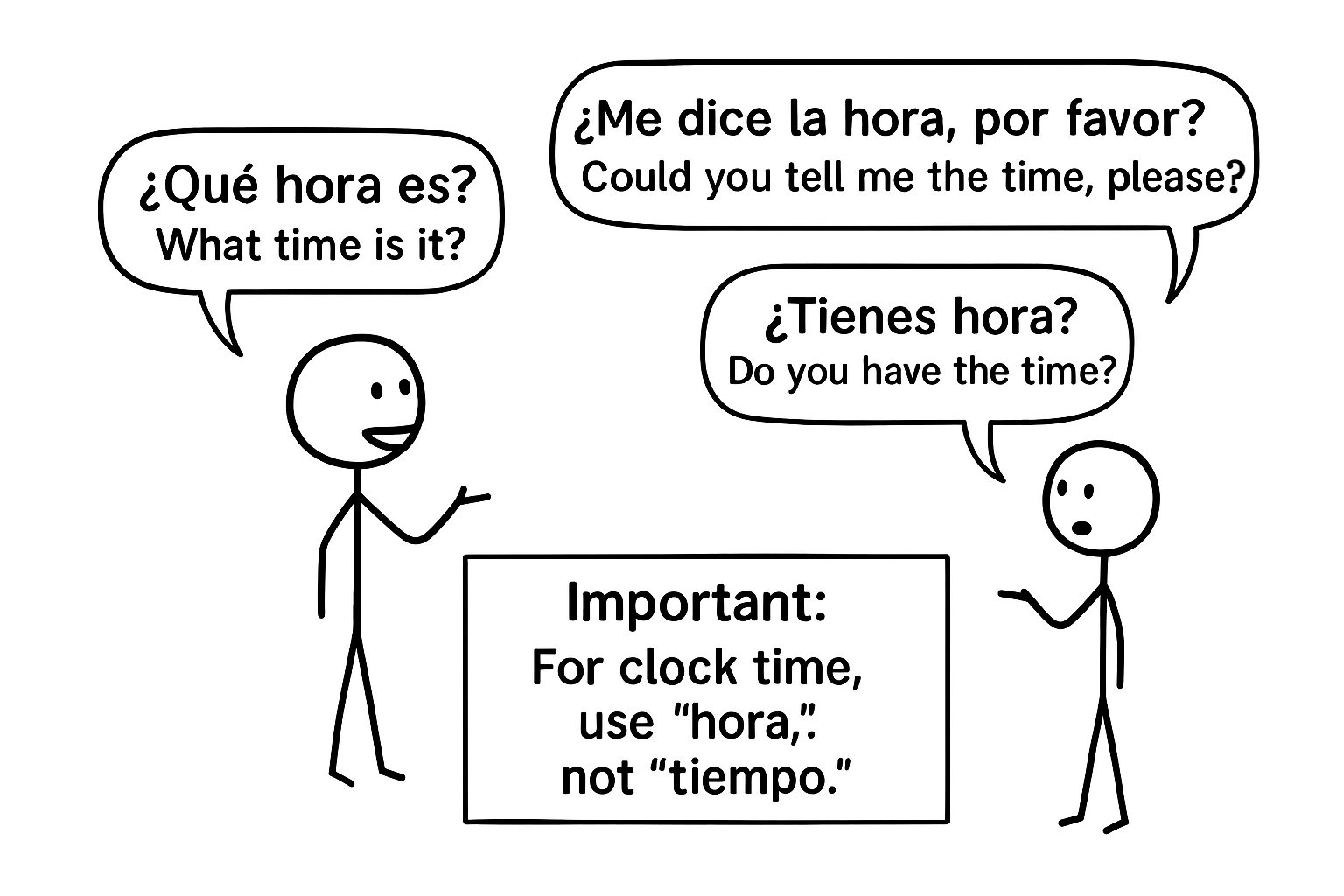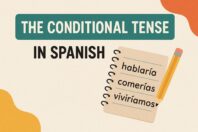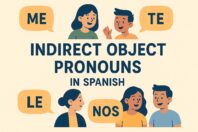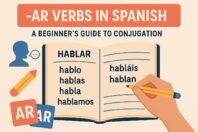The Complete Guide to Telling Time in Spanish

Get our free email course, Shortcut to Conversational.
Have conversations faster, understand people when they speak fast, and other tested tips to learn faster.
More infoLearning how to tell time in Spanish is one of those must-have skills for everyday conversations. You will use it to catch a bus, plan a dinner, or avoid showing up at midnight to a noon party. The good news: the rules are simple, the patterns repeat, and with a few memory hooks, you will be answering “¿Qué hora es?” like a pro. Let’s go.
How to ask the time in Spanish
The standard question is:
- ¿Qué hora es? – “What time is it?”
Other common ways:
- ¿Me dice la hora, por favor? / ¿Me puede decir la hora? – “Could you tell me the time, please?”
- ¿Tienes hora? (casual) – “Do you have the time?”
- In some regions, you will also hear ¿Qué horas son? (same meaning).
Important: for clock time, Spanish uses hora, not tiempo. Tiempo means “time” in a general sense (and “weather”). So do not say ¿Qué tiempo es?
Mini dialogue
- A: ¿Qué hora es?
- What time is it?
- B: Son las dos y media.
- It is two-thirty.
- A: ¡Gracias!
- Thanks!
The core pattern: ‘es la’ vs ‘son las’
Spanish treats “time” as “hour(s).” Use the verb ser (“to be”) with la/las because hora is feminine.
- Es la una. – “It is one o’clock.” (singular hour)
- Son las dos. – “It is two o’clock.” (plural hours)
To emphasize exact hours, add en punto:
- Son las cinco en punto. – “It is five o’clock.”
- Es la una en punto. – “It is one o’clock.”
Why una and not uno for 1:00? Because hora is feminine: una hora → es la una.
Minutes before and after the hour
There are two friendly ways to say minutes.
1) Addition with “y” (0–30)
Say the hour + y + minutes:
- Son las ocho y cinco. – “It is 8:05.”
- Es la una y diez. – “It is 1:10.”
- Son las cuatro y veinte. – “It is 4:20.”
Special phrases:
- y cuarto = “and a quarter” (15) → Son las siete y cuarto. – “It is 7:15.”
- y media = “and a half” (30) → Son las cuatro y media. – “It is 4:30.”
2) Subtraction with “menos” (31–59)
State the next hour, then subtract minutes with menos:
- Son las tres menos diez. – “It is 2:50.” (ten to three)
- Son las nueve menos cuarto. – “It is 8:45.” (quarter to nine)
- Son las ocho menos veinte. – “It is 7:40.” (twenty to eight)
You will also hear para in parts of Latin America:
- Son diez para las tres. – “It is ten to three.”
- Un cuarto para las nueve. – “Quarter to nine.”
If “menos/para” feels tricky at first, it is perfectly okay to stick to addition:
- Son las ocho y cincuenta. – “It is 8:50.”
Noon, midnight, and parts of the day
Spanish usually avoids saying “a.m.” and “p.m.” in speech. Instead, add a phrase that marks the part of the day:
- de la mañana – “in the morning” (roughly, after midnight until noon)
Son las diez de la mañana. – “It is 10:00 in the morning.” - de la tarde – “in the afternoon/early evening”
Son las seis y cinco de la tarde. – “It is 6:05 in the evening.” - de la noche – “at night”
Son las nueve de la noche. – “It is 9:00 at night.”
Two special words:
- mediodía – noon
Es mediodía. / Son las doce del mediodía. – “It is noon.” - medianoche – midnight
Es medianoche. / Son las doce de la noche. – “It is midnight.”
You may also hear la madrugada for the very early morning hours (roughly 1:00–5:00 a.m.):
Son las cuatro de la madrugada. – “It is 4 a.m.”
Asking when something happens: “¿A qué hora…?”
To ask “At what time…?” say ¿A qué hora…?
- ¿A qué hora empieza la película? – “What time does the movie start?”
- ¿A qué hora es la reunión? – “What time is the meeting?”
Answer with a la (for 1:00) or a las (for other hours):
- Es a la una. – “It is at one.”
- Es a las ocho. – “It is at eight.”
- Mi tren sale a las seis y media de la mañana. – “My train leaves at 6:30 a.m.”
- La fiesta empieza a las siete de la tarde. – “The party starts at 7 p.m.”
Useful scheduling add-ons:
- desde las… hasta las… – “from… to…”
El evento es desde las tres hasta las cinco. – “The event is from 3 to 5.” - sobre / alrededor de las… – “around…”
Nos vemos sobre las ocho. – “See you around eight.” - antes de / después de – “before / after”
Llegaré antes de las dos. – “I will arrive before two.”
The 12-hour vs 24-hour clock
In everyday speech, Spanish speakers generally use the 12-hour clock plus de la mañana/tarde/noche. In writing—especially timetables, tickets, emails, or signage—you will often see the 24-hour clock (also called “military time” in English).
- 14:00 → las dos de la tarde
- 21:30 → las nueve y media de la noche
- 07:05 → las siete y cinco de la mañana
When reading a 24-hour time out loud, many people switch it back to the 12-hour form with the part of the day:
La salida es a las 16:20 → “The departure is at four-twenty in the afternoon.”
If you do pronounce it as written, it can sound like “dieciséis veinte” (sixteen twenty), but converting to the 12-hour version is friendlier in conversation.
Handy modifiers and fuzzy time
Real life is messy, and Spanish has great little words for “ish” times:
- en punto – on the dot
Quedamos a las siete en punto. – “Let’s meet at seven sharp.” - y pico – and a bit
Son las cuatro y pico. – “It is a little after four.” - casi – almost
Casi son las ocho. – “It is almost eight.” - pasadas las… – just after
Pasadas las tres, empezamos. – “Sometime after three, we will begin.” - más o menos – more or less
A las seis, más o menos. – “At six, more or less.” - faltan [minutos] para las… – [minutes] to…
Faltan cinco para las nueve. – “It is five to nine.” - dentro de [tiempo] – in [time from now]
Llego dentro de diez minutos. – “I will arrive in ten minutes.” - hace [tiempo] – [time] ago
Llegué hace media hora. – “I arrived half an hour ago.”
Quick reference table
| Pattern / Phrase | Example (Spanish) | English meaning |
| Ask the time | ¿Qué hora es? | What time is it? |
| Polite ask | ¿Me dice la hora, por favor? | Could you tell me the time, please? |
| Casual ask | ¿Tienes hora? | Do you have the time? |
| Exact hour (1:00) | Es la una (en punto). | It is 1:00 (on the dot). |
| Exact hour (others) | Son las seis (en punto). | It is 6:00 (on the dot). |
| Minutes after (0–30) | Son las dos y cinco. | It is 2:05. |
| Quarter past | Son las siete y cuarto. | It is 7:15. |
| Half past | Son las cuatro y media. | It is 4:30. |
| Minutes to (31–59) | Son las tres menos diez. | It is 2:50. |
| Quarter to | Son las nueve menos cuarto. | It is 8:45. |
| Noon / midnight | Es mediodía. / Es medianoche. | It is noon. / It is midnight. |
| Morning / afternoon / night | de la mañana/tarde/noche | in the morning/afternoon/night |
| At what time? | ¿A qué hora es…? | At what time is…? |
| At [hour] | Es a la una. / Es a las dos. | It is at one. / It is at two. |
| Around / approximately | sobre / alrededor de las… | around… |
| Sharp | en punto | on the dot |
| A bit after | y pico | and a bit |
| Almost | casi | almost |
Phrase bank: examples you will actually use
- ¿Qué hora es? – “What time is it?”
- ¿A qué hora nos vemos? – “What time are we meeting?”
- Nos vemos a las ocho de la noche. – “See you at 8 p.m.”
- La clase empieza a las diez de la mañana. – “Class starts at 10 a.m.”
- Son las cinco en punto. – “It is exactly five o’clock.”
- Es la una y cuarto. – “It is 1:15.”
- Son las ocho menos veinte. – “It is 7:40.”
- Llegaré dentro de quince minutos. – “I will arrive in fifteen minutes.”
- ¿A qué hora cierran? – “What time do you close?”
- Cerramos a las nueve de la noche. – “We close at 9 p.m.”
- ¿A qué hora sale el tren? – “What time does the train leave?”
- Sale a las seis y media de la tarde. – “It leaves at 6:30 p.m.”
- ¡Siento llegar tarde! – “Sorry I am late!”
Practice: say the time
Try these. Cover the answers first, then check yourself.
- 1:10 → __________
- 3:15 → __________
- 4:30 → __________
- 5:50 → __________ (give two versions)
- 8:45 → __________ (give two versions)
- “The meeting is at 2 p.m.” → __________
- “What time is the concert?” → __________
Answers
- Es la una y diez. – “It is 1:10.”
- Son las tres y cuarto. – “It is 3:15.”
- Son las cuatro y media. – “It is 4:30.”
- Son las cinco y cincuenta. / Son las seis menos diez. – “It is 5:50.” / “Ten to six.”
- Son las ocho y cuarenta y cinco. / Son las nueve menos cuarto. – “It is 8:45.” / “Quarter to nine.”
- La reunión es a las dos de la tarde.
- ¿A qué hora es el concierto?
Extra clarity on numbers you will need most
Spanish numbers 1–12 for hours:
- una, dos, tres, cuatro, cinco, seis, siete, ocho, nueve, diez, once, doce
Common minute words:
- cinco (5), diez (10), y cuarto (15), veinte (20), veinticinco (25), y media (30), treinta y cinco (35), cuarenta (40), cuarenta y cinco (45), cincuenta (50), cincuenta y cinco (55)
If you are comfortable with these, you can tell any time you see.
Summary: your four-step cheat sheet
Use this 30-second cheat sheet to ask and tell time in Spanish. Follow the four steps and swap in your hours/minutes as needed.
- Ask
- Now: “¿Qué hora es?”
- Schedule: “¿A qué hora…?”
- Say the hour
- 1:00 → “Es la una.”
- 2–12 → “Son las [hora].” (e.g., “Son las siete.”)
- Add minutes
- 0–30: use y → 3:15 “Son las tres y cuarto”; 4:30 “Son las cuatro y media.”
- 31–59: menos + next hour → 8:50 “Son las nueve menos diez”; 8:45 “Son las nueve menos cuarto.”
- Safe fallback anywhere: addition → 5:50 “Son las cinco y cincuenta.”
- Clarify day part (instead of a.m./p.m.)
- “de la mañana”, “de la tarde”, “de la noche” → 7:00 p.m. “Son las siete de la noche.”
- Specials: noon “Es mediodía.”; midnight “Es medianoche.”
Practice with the next three times you check a clock. Say one now, one later, and one schedule, and it will stick.




